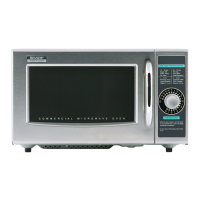
Do you have a question about the Sharp R-21LC and is the answer not in the manual?
| Capacity | 21 L |
|---|---|
| Control Type | Mechanical |
| Interior Material | Stainless Steel |
| Power Levels | 5 |
| Voltage | 230 V |
| Weight | 22 lbs |
Contact information for nearest Sharp Authorized Servicer and Parts Distributor.
Address for additional information and service problems, warranty, missing items.
Web address for Sharp USA for product information and support.
Do not operate oven with the door open to avoid harmful microwave energy exposure.
Keep door front face and sealing surfaces clean; do not place objects between them.
Do not operate if oven is damaged, especially door, hinges, or seals.
Only qualified service personnel should adjust or repair the oven.
Specifies warranty duration for different models and parts like the magnetron tube.
Instructions on how to obtain service and product information via phone or website.
Emphasizes reading all instructions before operating the appliance.
Appliance must be grounded; connect only to properly grounded outlets.
Avoid storing/using outdoors, near water, or with damaged cords/plugs.
Instructions for preventing fires, including not overcooking and proper handling of ignition.
Steps to prevent sudden boiling of overheated liquids like water or coffee.
Specifies voltage, frequency, and amperage requirements for the appliance.
Guidelines for using extension cords, including type and safety precautions.
Tips to resolve interference issues between the microwave and radio/TV.
Instructions for proper placement, ventilation, and securing the microwave oven.
Lists and identifies external components of the microwave oven.
Lists and identifies internal components of the microwave oven.
Detailed explanation of each button and its function on the control panel.
A chart providing time and procedure for defrosting various frozen foods.
Essential steps to follow before operating the microwave oven.
Instructions on using memory banks to store and recall cooking programs.
How to cook two servings or double the amount using a memory program.
Step-by-step guide on how to cook using a pre-programmed memory setting.
Instructions for changing and programming memory banks for cooking sequences.
Guide to setting cooking time and power level for multi-stage memory programs.
How to adjust the magnification factor for doubling food quantities in memory.
How to retrieve stored cooking time and power level information for a memory.
How to check the stored magnification factor for double quantity cooking.
Instructions for setting cooking time and power levels for different models.
Guide for programming multi-stage cooking sequences on the R-21LT model.
Chart detailing defrosting times for various foods based on weight and thickness.
How to check the total usage counts for the oven and its functions.
Instructions on how to reset or clear the usage counters.
How to adjust the oven's audible signal sound or turn it off.
Instructions for activating and deactivating the oven's demonstration mode.
Pre-service checks and common error codes (EE 9) to diagnose issues.
Critical warnings about operating and cleaning the oven, splash covers, and shelves.
How to clean the outside surfaces of the microwave oven.
Specific instructions for cleaning the control panel to avoid damage.
Instructions for cleaning the inside of the oven, including splash covers.
How to clean the oven door and seals to ensure proper function and safety.
Guidance on suitable and unsuitable utensils for microwave cooking.
Specific advice on using metal foil, containers, and skewers in the microwave.
Information on using glass, ceramic, and china items, including warnings about metallic trim.
Guidance on using paper products, including warnings about recycled paper.
Advice on using plastic and foam containers, including precautions for heat and seals.
Recommendation against using melamine for microwave oven use.
Guidance on using wicker, wood, and straw items for short periods.
Tips on arranging food, standing time, checking doneness, and partial cooking.
Advice on heating pastries, rolls, and muffins for best results.
Guidance for heating eggs, sausage, and other breakfast foods.
Tips for heating sandwiches to prevent dryness and ensure even warming.
Instructions for arranging and covering casseroles for optimal heating.
Guidance on heating vegetables, including arrangement and covering.
Instructions for defrosting using Express Defrost or Selectapower.
Explanation of factors influencing microwave heating times, such as food density and temperature.
How the starting temperature of food affects its microwave heating time.
Effect of salt, fat, protein, and density on microwave heating speed.
How food thickness, shape, and mounding affect heating time.
Explanation of how the amount of food affects total heating time.
Specific heating times for pastries, rolls, and baked goods at 100% power.
Heating times for breakfast items like eggs, bacon, and sausage.
Heating times for various types of sandwiches.
Heating times for different types of casseroles.
Heating times for various vegetables at 100% power.
Heating times for plated meals and primary cooking items like bacon and eggs.
Key reminders for safe operation, including not operating empty and metal usage.
Reminders for heating eggs, popcorn, liquids, and using recycled paper products.
Details on electrical requirements, dimensions, weight, and test procedures.
Information on compliance with FCC, DHHS, NSF, and UL standards.
Quick guide to checking stored information in memory banks.
Quick guide to checking oven usage counts and clearing them.
Quick guide for programming multi-stage cooking on the R-21LT.
Basic operation guide for the R-21LC model using the Light Up Dial.
Quick steps for cooking using a saved memory program.
Quick steps for cooking double servings using memory.
Quick steps for programming cooking stages into memory.
Quick steps for setting time and power level for cooking.
Quick steps for using the Express Defrost function.
